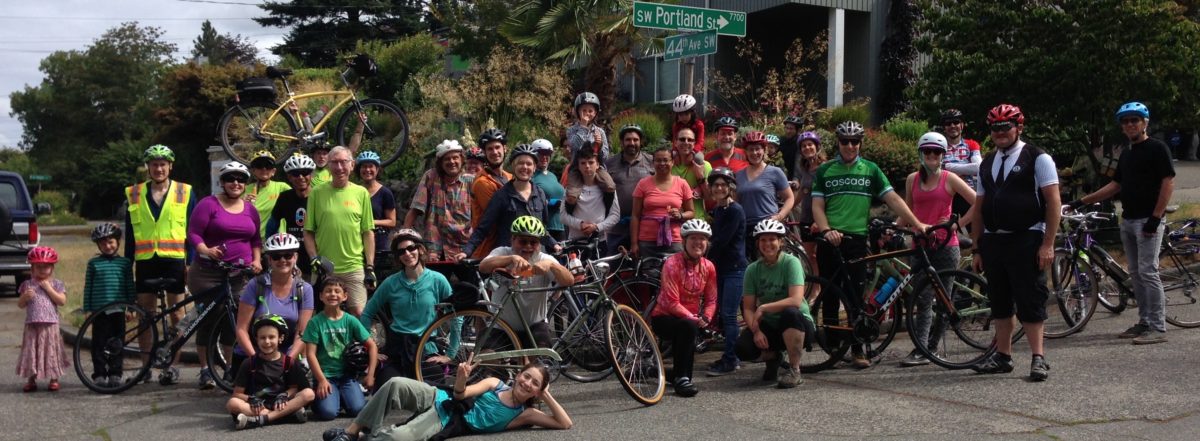Emily asked us how to ride her bike safely from West Seattle to work at the VA Hospital. Erin asked how to ride to UW Medical Center. Travis is willing to commute on his new e-bike all the way to Green Lake. We are fielding many inquiries. Bike sales are taking off. With alternate route traffic delays looming, Georgetown and South Park residents are fearful of gridlock, air pollution, and for the safety of their children walking to school. We know that using bikes instead of cars will help free up capacity on the remaining bridges. But we need a few improvements make it safe and efficient for these folks and many more people to bike instead of drive.
West Seattle Bike Connections with Duwamish Valley Safe Streets, Seattle Neighborhood Greenways and Cascade Bicycle Club sent a detailed proposal to the City yesterday, summarized here.
OUR GOAL
Mobility for West Seattle, SODO and the Duwamish Valley.
Keep people and goods moving safely across much lower-capacity bridges over the Duwamish while the West Seattle High-Rise Bridge is closed. Mitigate impacts on our communities. Honor Seattle’s commitments to equitable transportation, our environment, social justice, and economic vitality.
STRATEGIES
Encourage or incentivize as many people as possible to use bikes or transit, or both, instead of driving private vehicles. Accomplish this before the end of COVID-19 restrictions.
-
- Improve conditions to make it safe, efficient and comfortable for people to ride bikes and transit.
- Concentrate on safety and wayfinding for biking and bike/transit connections:
-
-
- On key West Seattle bike routes to the Spokane Street bridge, and from the bridge on East Marginal Way S to Pioneer Square, Downtown, SODO Trail, and SODO light rail station.
- On bike routes to the 1st Ave S bridge and South Park Bridge, and bike routes within South Park and Georgetown that are impacted by alternate route traffic and may also be needed for biking from West Seattle whenever the Spokane Street Bridge is closed.
- On routes to and bike parking at the King County Water Taxi dock at Seacrest.
-
-
- Protect Neighborhood Greenway streets near alternate routes from cut-through traffic, to keep them safe for residents and for walking and biking by people of all ages and abilities.
- Ensure availability of bikeshare bikes. Provide bikeshare discounts and bike/e-bike financing to people with low incomes.
- Use up to 1% of the bridge repair cost for mitigation measures for bike and pedestrian safety and efficiency.
- Use advocacy groups like West Seattle Bike Connections, Duwamish Valley Safe Streets, Cascade Bicycle Club and Seattle Neighborhood Greenways to:
-
-
- Identify opportunities to improve safety and wayfinding.
- Provide route advice, route maps, bike buddy matching, bike trains and educational rides.
- Connect people to good advice and local bike shops for selecting and maintaining bikes, including e-bikes.
-
RECOMMENDED WORK FOR STREET SAFETY
PRESERVE these already planned and funded projects on schedule:
EXPEDITE these key Bicycle Master Plan high priority routes:
-
- Sylvan Way SW / SW Orchard and east to Highland Park
- Highland Park Way SW off street multi-use path
- 1st Ave S Bridge to 1st Ave S safe route north from bridge
- SW Roxbury bike lanes without reducing traffic lanes
QUICKLY IMPLEMENT spot improvements for wayfinding and safe routes:
-
- On Spokane Street Bridge routes at the Chelan 5-way intersection; on Fauntleroy Way and Admiral Way; on the “Nucor Trail” connection from Delridge to the Alki Trail; at Terminal 18 trail crossings on Harbor Island; on East Marginal Way; and on the connections to the SODO light rail station and SODO Trail.
- On 1st Avenue South Bridge and South Park Bridge routes at the Duwamish Trail “missing link from the Alki Trail; on Highland Park Way at West Marginal Way; at rough rail crossings on the Duwamish Trail and in Georgetown; and on routes in Georgetown through SODO.
































